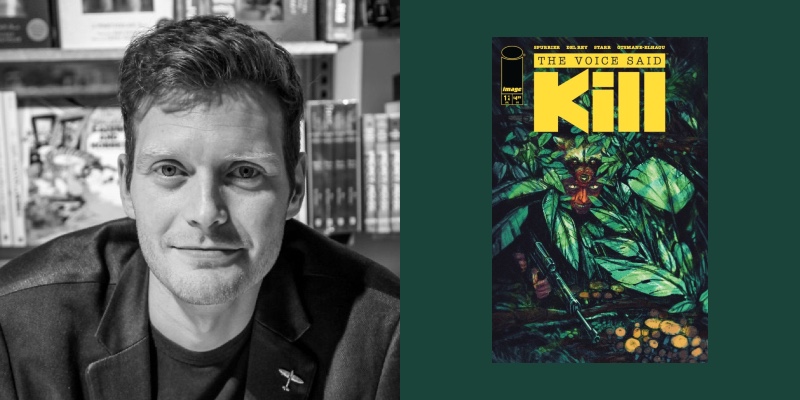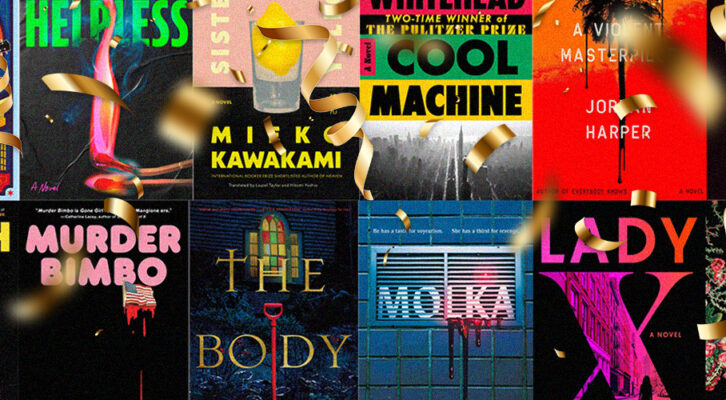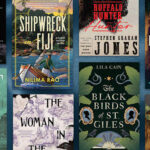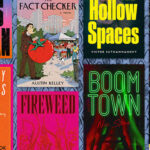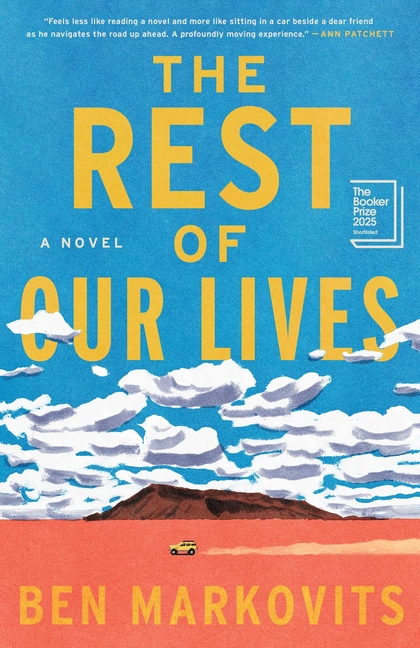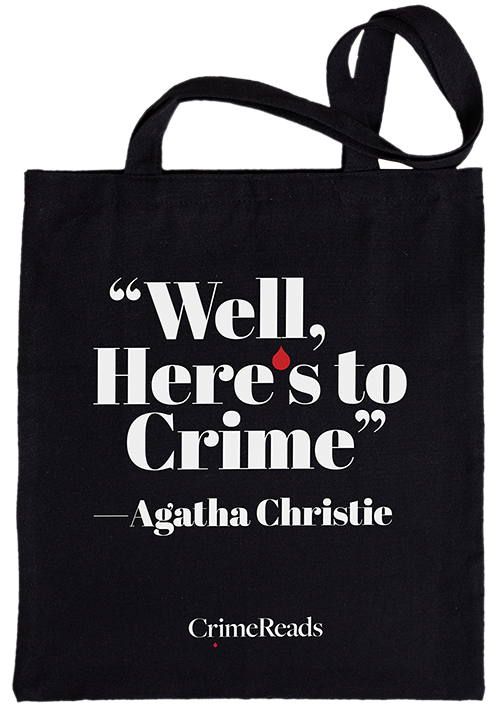It’s a matter of some frustration, to those of us who love both, that prose novels and graphic novels are held to be so radically unalike.
I’ve written extensively in both media, and can’t deny the differences are many and deep. Fandoms rarely cross the rails. Those who’ve read and enjoyed my crime novels (Contract, A Serpent Uncoiled) only occasionally find their way to my comics (Coda, The Spire, Damn Them All) and vice versa. Those who do so inevitably find that the elements of my work they enjoyed in one sphere are entirely present in the other, yet the embracing of a whole new world of stories remains oddly non-instinctive.
I’m fascinated by why that should be. And since I’m on the cusp of releasing The Voice Said Kill, a pure crime comic delightfully categorized by the publisher as “Louisiana swamp noir”, I thought it a good opportunity to take a look at the whole problem, and suggest some gateway titles to make the barriers more porous.
We’ve all felt an occasional flicker of frustration, I think, at seeing our favourite genres of novel ghettoised in bookstores or libraries. It’s as if they’re somehow niche, shameful; less serious or capable of brilliance than the whimsically-titled pastel tones of the Contemporary Fiction section.
Imagine, then, the gloom of the committed comics reader, who visits the same store only to find their entire medium, with all its variety and magic, not only dumped into one dingy little corner, unsorted by genre, but dominated by a technicolor saturation of superhero pablum.
So let’s start with that seemingly obvious but little-stated distinction: “comics” do not automatically mean “spandex.”
I keep calling them “comics”, by the way, rather than any of the euphemistic descriptors we hope will sidestep childish associations (“graphic novels!” “sequential narratives!”) because I hate to see an entire artform tainted by one little corner of its output. As far as I’m concerned Art Spiegelman’s Maus is a comic. Joe Sacco’s Palestine is a comic. Sure, so’s Cyber Frog, but you don’t hear people refusing to call The Godfather “a movie” just because so too is Plan 9 From Outer Space.
Comics have their own alchemy. The reader’s unconscious mind is working quite differently when animating static moments or synesthetically converting space into time, as it does with comics, than when decoding pages of purely abstract text. Neither is simpler nor more complex than the other; each is an absurdly sophisticated expression of the human brain’s ability to conjure stories out of marks on printed paper. Each is spellbinding in its own way. I’ve read crime comics that move me to tears with a few lines of drawn expression – indeed, The Voice Said Kill is one of them – and crime novels that bore me to tears with diarrheic tsunamis of cliche.
There are, I concede, some pragmatic differences that might seem insurmountable. Many comics tend to enjoy a first life as monthly periodicals in comicbook stores – “floppies”, as they’re rather unpleasantly known – before being collected into paperback volumes. It can be an abstruse-seeming system, daunting to enter. But one need only look back at the fizzing furore that surrounded the release of each new chapter of Oliver Twist or The Old Curiosity Shop to recognize there’s a particular thrill in waiting for serialized fiction.
The good news is that most comicbook stores these days are bright, welcoming spaces, and it’s easy to subscribe to a monthly title for as little or long as you wish. Better yet, for e-Reader advocates, most monthly comics are released digitally through multiple outlets, on every platform, the same day they land on shelves.
With The Voice Said Kill, which is available from July 23rd, we’ve been encouraging first-timers to visit their local comic shop in order to pre-order the first chapter. (If nothing else, it gives you an excuse to step into an unfamiliar world and have a browse.) To that end we’ve been sharing a preview of the first issue as far and wide as we can, with a clever little widget at the end which lets you locate your nearest outlet.
You can read that preview RIGHT HERE.
But whether or not the swampy impressionistic stylings of The Voice Said Kill are for you, here’s my contention: if you love crime novels there’s no reason why you can’t – why you shouldn’t – love crime comics. They might thrill you in different ways, mystify you via different mechanisms, deploy their gasp-worthy twists from different angles, but thrill you, mystify you and make you gasp they absolutely will.
So here, in an attempt to persuade you to at least dip your toes into warm new waters, is a short and extremely incomplete list of the best crime comics. Enjoy!
(Couple of quick notes on how I’ve compiled the below. I’ve tended to skew recent. I’m trying to pander to the tastes of modern readers of crime prose, rather than celebrate the golden age origins of the genre. I’ve also avoided anything that leans too heavily on “shared world” knowledge (hence no Gotham Central), or anything where the crime element is contingent on science-fiction or fantasy flourishes (so no The Private Eye). Okay. Let’s do this.)
CRIMINAL
Brubaker & Phillips
The trophy in the window of comics’ crime cabinet. These gorgeous, grim, endlessly surprising tales revolve around different protagonists linked through their beginnings in the fictional Center City. The sprawling cast of pickpockets, corrupt cops, killers and thieves never succumb to cliche and never feel anything other than utterly human. Each book comes to a razor-tooled conclusion. A masterclass from writer and artist alike, and the subject of a forthcoming TV show.
BRONX KILL
Milligan & Romberger
A tightly-wrought tale of murder, abduction and generational expectation. It gets a particularly highlighted spot in this list because the main character is much given to writing crime prose. There’s some interesting resonance between the textual excerpts of the novel he’s working on and the visually-rendered story of his real life. If ever there were a perfectly-engineered gateway between prose and graphic novels for crime-fans, it’s this.
THE GOOD ASIAN
Pichetshote & Tefenkgi
Historical noir at its very best, melding the hunt for a killer with a clear-eyed study of a complex and fascinating detective. Set in 1936, intricately concerned with the (little-known) Immigration Ban, this is a diligently researched and beautifully rendered meditation on the Chinese-American experience, and a dark snapshot of a corrupt and abusive system.
SCALPED
Aaron & Guera
A sprawling multi-character epic which simultaneously provides all the thrills and tension you’d expect of great crime fiction, while also delving deep into the lived experiences of deeply othered communities; in this case the Oglala Lakota of the (fictional) Prairie Rose reservation. The tale begins with Dashiell “Dash” Bad Horse returning to the rez after many years away, keeping his FBI badge carefully hidden, then explodes in multiple delicious directions to interrogate poverty, drug addiction, alcoholism, local politics and the preservation of cultural identity.
MATADOR
Grayson & Stelfreeze
A female detective, painfully well accustomed to dealing with the locker-room bullshit of her male colleagues, is drawn into the gravity-well of The Matador: a killer so mysterious he’s assumed to be an urban legend. Her life and preconceptions are overthrown by the chain of murderous secrets that slither up into the light. I’ve included this here not only because it’s great, but because it leans closer than any of the other titles to the sort of heightened “life-dialled-up-to-11” reality which comics are often assumed to present. If your bag is stark, unexaggerated realism then I refer you to other titles in this list, but I think it’s worth making the case that tales of heightened reality need be no less clever or sophisticated than more buttoned-down fare.
SWEETS
Chamberlain
What could’ve been a pretty conventional tale – “Detective Hunts Spree Killer” – takes on multiple layers of extra depth through circumstance, location and timing. Our hero, New Orleans detective Delatte, conducts his investigation in a window of time sandwiched between two tragedies: he’s just buried his only daughter, and Hurricane Katrina is about to make landfall. A study in historical disaster, deeply-felt personal grief, and a deftly-subverted take on the serial killer tale.
GOLDFISH
Bendis
The rolls royce of comicbook noir, oozing shadowy criminality from every black-and-white panel. Here a con-man – known by the sobriquet “Goldfish” – returns to his old turf to reclaim the son he hasn’t seen in 10 years. A son presently in the custody of his mother, a local queenpin and owner of a spectacularly-rendered nightclub/bordello/casino. A captivating exercise in drawing readers into a murky, cinematic dream through clever use of the medium’s unique toolbox.
THE SHERIFF OF BABYLON
King & Gerards
A fascinating fusion of the familiar and the alien. In the former category, here we follow an ex-cop as he attempts to solve the murder of an acquaintance. In the latter: it all goes down in the mean streets of Baghdad, our hero is a US defence consultant, and the victim is one of his police recruits. A sharply-realised glimpse into another world, written by a former CIA officer and drawn by one of the best atmosphere-wranglers in comics.
MS. TREE
Collins & Beatty
A curious confection from out on the fringes of genre, in which a female detective takes over her dead husband’s P.I. business. What follows is a unique oscillation between deftly-handled investigative tropes and the warts-and-all familial/relationship dramas of our heroine. A local criminal clan wobbles between antagonism and weirdly-charming acts of affection, and our two-fisted, six-foot-tall, pneumatically-built protagonist cheerfully beats the living shit out of anyone in her way. Even after falling pregnant. If some of the material skews a little problematic by today’s standards, that can be forgiven as a product of time’s passage, or possibly absorbed into part of the series’ defining charm: the strange suspicion that one is reading is an artefact of crime fiction from a divergent parallel reality.
A peculiar and beautiful series.
PARKER
Westlake / Cooke
An honourable mention here, though not strictly speaking a comicbook original. Parker of course began life as a beloved series of novels by the absurdly talented Donald E. Westlake, whose protective instincts allowed for an occasional movie adaptation but never stretched so far as to permit the makers to use the character’s novelized name. That all changed when near-legendary artist Darwyn Cooke created a faithful adaptation in the comics medium. Westlake adored the work but sadly died before it was published. Permitted to keep going by Westlake’s estate, Cooke created a handful of the best crime comics the world will ever see before he too passed away.
These aren’t just recommended reads for those who love crime fiction, but a solid gold requisite. The purest expression of how an exceptional artist can elevate a writer’s vision.

